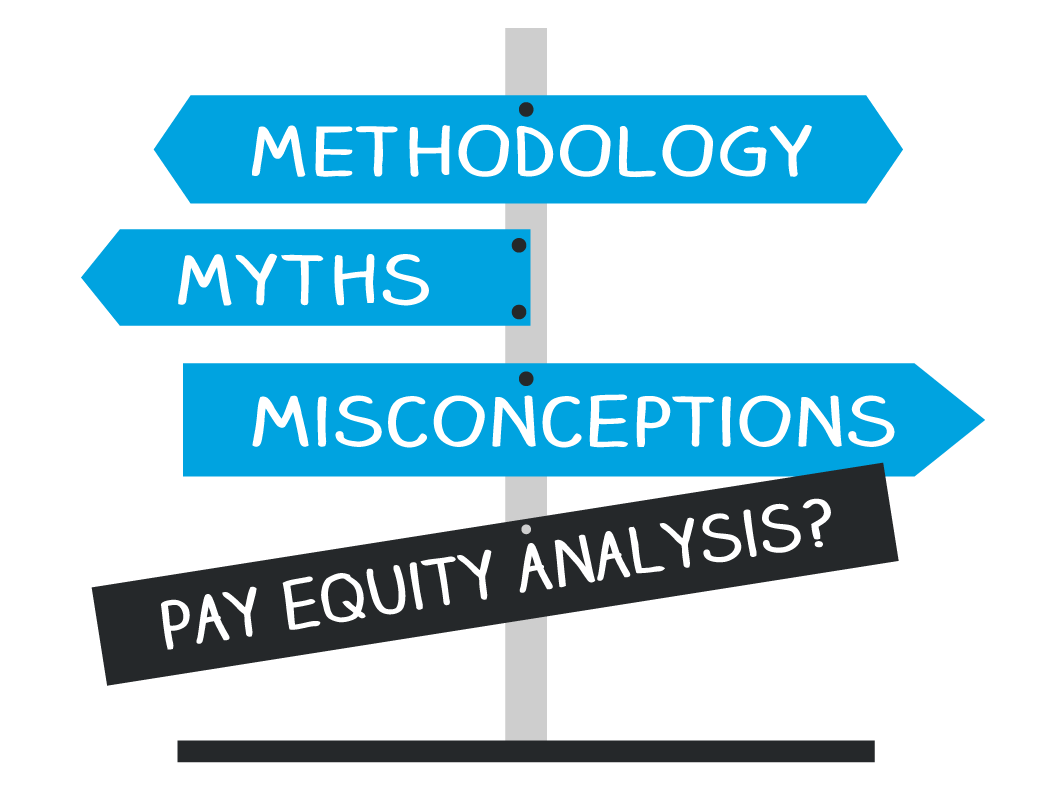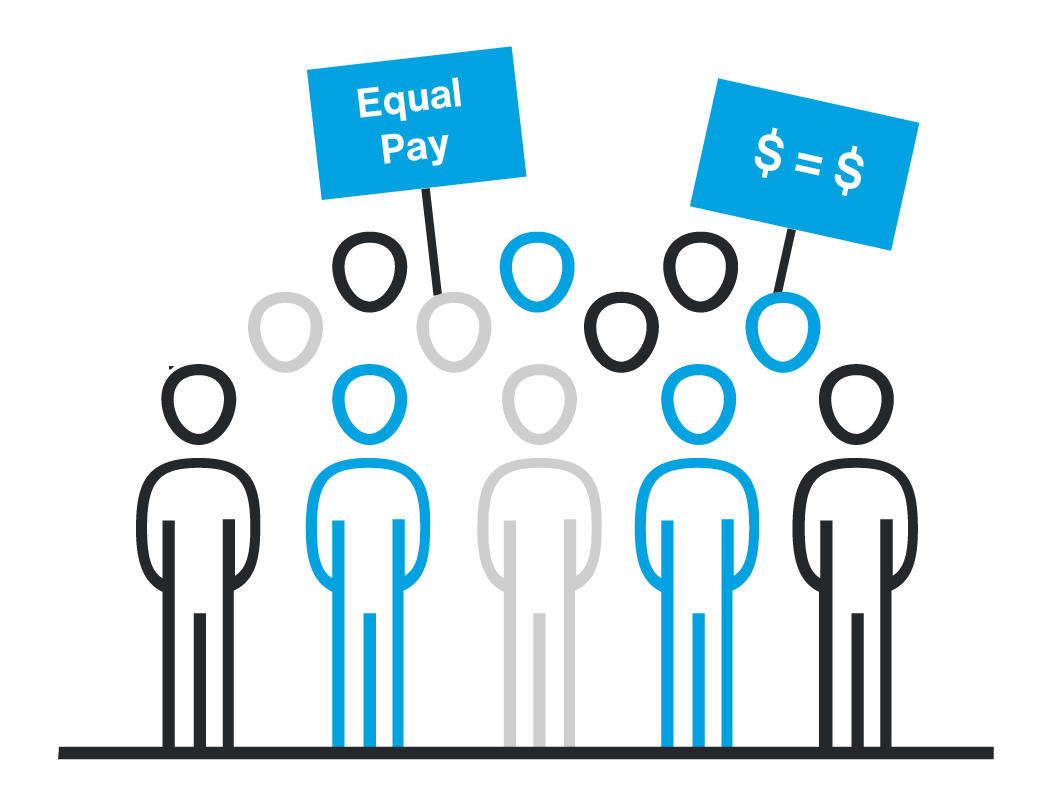Pay Equity Deep Dive Part 8: Pay Equity Methodology Myths and Misconceptions Continued

Want more expert insights on the topic of pay equity? Access our entire Pay Equity Deep Dive Series.
Continuing with our Pay Equity Deep Dive Series, we reveal three more pay equity methodology myths and misconceptions. These dive deeper into pay equity analysis, examining intersectionality, reference class practices, and remediation.
By sharing and scrutinizing common myths and misconceptions, we aim to help organizations refine their methods to address pay equity more effectively.
Myth 5: Your U.S. pay equity analysis should examine gender and race/ethnicity separately.
When conducting a pay equity analysis on a U.S. workforce, it’s commonplace to examine gender and race/ethnicity separately. By separately, I mean running a multiple regression analysis to examine the relationship between gender and pay, followed by a separate multiple regression analysis to examine the relationship between race/ethnicity and pay (or the relationship between any demographic characteristic and pay).
This approach is problematic for two reasons. First, as part of your pay equity analysis, you create a statistical model of pay for each of your Pay Analysis Groups (PAGs). Each model includes Wage Influencing Factors (WIFs), which are compensable factors that one would expect to influence employee pay. The regression weights associated with these WIFs are used to compute an employee’s neutral pay prediction.
If you run separate regression analyses to examine the relationship between gender and pay and between race/ethnicity and pay, you’ll end up with two sets of regression weights and two sets of predicted pay values. Predicted pay values are an important consideration in crafting a remediation strategy, so working with two (or more) sets of predicted pay values will be problematic to reconcile during remediation.
Achieve Authentic Pay Equity with Software
Second, if both race/ethnicity and gender are related to pay, then excluding race/ethnicity from a regression analysis that examines the relationship between gender and pay will result in omitted variable bias. In the words of Statistics By Jim (a great resource!), “Omitted variable bias (OVB) occurs when a regression model excludes a relevant variable. The absence of these critical variables can skew the estimated relationships between variables in the model, potentially leading to erroneous interpretations. This bias can exaggerate, mask, or entirely flip the direction of the estimated relationship between an independent and dependent variable.”
What this means is that to estimate the relationship between gender and pay in the U.S., the regression analysis should include race/ethnicity as well, plus relevant WIFs. Otherwise, our estimate of the gender effect may incorrectly attribute variation in pay to gender that is actually due to race/ethnicity differences. Similarly, our estimates of the effects of WIFs may incorrectly attribute additional variation in pay to WIFs that is actually due to race/ethnicity differences. If race/ethnicity plays no role in driving pay differences, its inclusion will not systematically distort gender or WIF effect measurements.
Myth 6: The reference class for gender should be male and the reference class for race/ethnicity should be White.
As part of a pay equity analysis, a reference class (i.e., basis of comparison) is identified for gender, race/ethnicity, and any other demographic characteristic included in the analysis.
The prevailing market approach is to impose a reference class of “Male” for gender globally and a reference class of “White” for race/ethnicity in the U.S. As an example, many organizations report their gender pay gap in the form of: “Women are paid xx cents-on-the-dollar compared to men.”
While this approach may be reasonable when reporting enterprise-wide pay equity results, it’s not the preferred approach when identifying and remediating pay disparities.
Our recommendation is to define the reference class based on the highest paid class in a Pay Analysis Group (PAG). For example, if an analysis reveals that men in a PAG are paid more than women, then “Male” is the reference class. Conversely, if an analysis reveals that women in the PAG are paid more than men, then “Female” is the reference class.
This approach means that some PAGs will have Male as the reference gender, and some will have Female (or Non-Binary) as the reference gender. Similarly, looking at race/ethnicity in the U.S., some PAGs will have White as the reference race/ethnicity, and some will have another race/ethnicity as the reference (e.g., Asian, Black, Hispanic).
The primary benefit of this approach is that it’s neutral in looking for pay disparities (i.e., any demographic class can be identified as having a disparity), thereby reducing the chance of missing any “reverse discrimination” risks. Moreover, in the U.S., this approach is in keeping with the Equal Pay Act of 1963 and Title VII of the Civil Rights Act of 1964.
For any jurisdiction-specific compliance analysis (e.g., Illinois Equal Pay Certificate), we recommend using the reference class required by the legislation.
Myth 7: There is no need to remediate pay disparities every year.
For most organizations, it’s advisable to remediate pay disparities annually. Remediating less often runs the risk of allowing pay inequities to fester, leading to large remediation costs, as well as the potential for incurring back-pay liabilities in the case of a lawsuit.
From a budgeting standpoint, most organizations are not able to make pay equity adjustments multiple times per year. Moreover, making pay equity adjustments outside of the merit process runs the risk of drawing unwanted attention to the adjustments.
That said, we recommend monitoring your pay equity situation throughout the year, either on a quarterly or semi-annual basis. Conducting a periodic pay equity audit provides feedback well in advance of your annual remediation process.
This periodic audit can help you understand how demographic changes within your workforce, changes in organizational structure, and changes in external market forces are affecting your pay equity outcomes.
An organization would be best served by proactively preventing pay inequities as pay decisions are made, and using its annual remediation process as a safeguard to address any pay inequities that remain.



